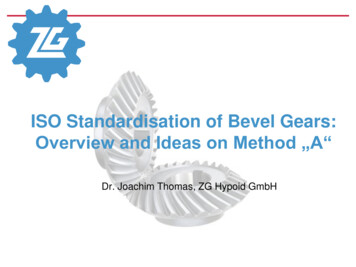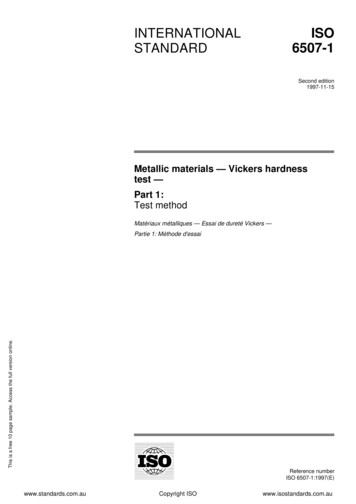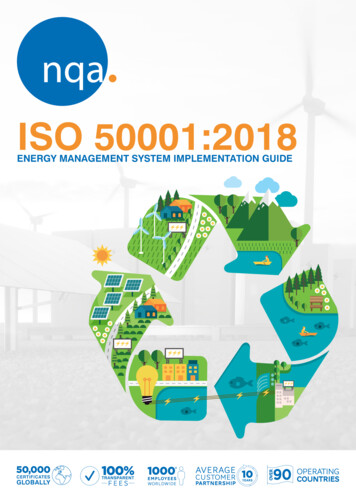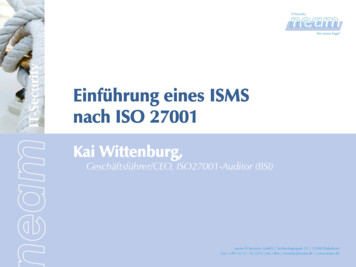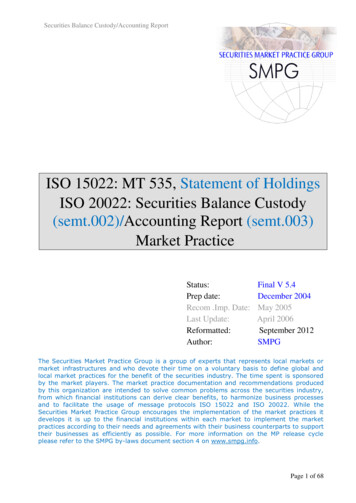
Transcription
Securities Balance Custody/Accounting ReportISO 15022: MT 535, Statement of HoldingsISO 20022: Securities Balance Custody(semt.002)/Accounting Report (semt.003)Market PracticeStatus:Prep date:Recom .Imp. Date:Last Update:Reformatted:Author:Final V 5.4December 2004May 2005April 2006September 2012SMPGThe Securities Market Practice Group is a group of experts that represents local markets ormarket infrastructures and who devote their time on a voluntary basis to define global andlocal market practices for the benefit of the securities industry. The time spent is sponsoredby the market players. The market practice documentation and recommendations producedby this organization are intended to solve common problems across the securities industry,from which financial institutions can derive clear benefits, to harmonize business processesand to facilitate the usage of message protocols ISO 15022 and ISO 20022. While theSecurities Market Practice Group encourages the implementation of the market practices itdevelops it is up to the financial institutions within each market to implement the marketpractices according to their needs and agreements with their business counterparts to supporttheir businesses as efficiently as possible. For more information on the MP release cycleplease refer to the SMPG by-laws document section 4 on www.smpg.info.Page 1 of 68
Securities Balance Custody/Accounting ReportI. SCOPE AND DEFINITIONS: . 4II. BACKGROUND: . 4III. ACTORS AND ROLES: . 4IV. ACTIVITY DIAGRAM: . 5A. PUSH MODE. 5B. PULL MODE . 6V. COMMUNICATION FLOW: . 7A. PUSH MODE. 7B. PULL MODE . 7VI. MARKET PRACTICE RULES: CUSTODY STATEMENT. 7A. SCOPE. . 7B. SEQUENCE DIAGRAM . 9. 9. 10C. COMMON MANDATORY BUSINESS DATA REQUIREMENTS: . 11D. OPTIONAL BUSINESS DATA REQUIREMENTS: . 13E. AGGREGATE BALANCE USAGE:. 151. Calculation . 152. Availability . 16F. SUB-BALANCE USAGE: . 171. Sub-balance types: . 172. Availability: . 173. Usage table: . 17G. ILLUSTRATIONS: THESE ILLUSTRATIONS ARE ELABORATED WITH THE CONNECTION BETWEEN MT535 ANDMT536 IN THE MT536 MP . 20H. PLACE OF SAFEKEEPING: . 27VII. MARKET PRACTICE RULES: ACCOUNTING STATEMENT . 52A. SCOPE . 52B. SEQUENCE DIAGRAM . 53. 53. 54C. COMMON MANDATORY BUSINESS DATA REQUIREMENTS: . 55D. OPTIONAL BUSINESS DATA REQUIREMENTS: . 57E. AGGREGATE BALANCE USAGE:. 59F. SUB- BALANCE USAGE: . 59G. ILLUSTRATIONS: . 60H. PLACE OF SAFEKEEPING: . 63VIII. APPENDIX - CUSTODY STATEMENT FOR SECURITIES LENDING AND BORROWINGACTIVITY. 64v5.0January 2006V5.1April 2006V5.2October2011SR 2006SR 2006Changes to previous versionsStatement frequency, complete/updates, statementPage 11 and 59basis indicator mandatory.Page 18, 19 andNew sub-balances information.23.UsageClarificationAddition of single andsafekeeping scenarios.multipleplace(s)ofReformattedRework of the whole MP based on the businessWholeprocess layout. ISO 20022 illustrations are alsodocument.includedPage 27 to 47Page 2 of 68
Securities Balance Custody/Accounting 012Addition of ISITC Appendix to cover Sec Lending &Section VIIIBorrowing ActivityPage 3 of 68
Securities Balance Custody/Accounting ReportI. Scope and definitions:This document provides guidelines for the usage of MT 535/semt.002 or semt.003. The current situation isnot satisfactory as many practices and usages co-exist leading to reconciliation and potentially settlementissues.This document is the outcome of extensive discussions in 2003 and 2004. This version provides, perstatement type and basis, detailed recommendations on how the MT 535 is to be used.II. Background:When the group discussed the issues linked to the MT 535, it became quickly obvious that there wereseveral reasons to the existing problems:- The misunderstanding of the statement types (custody versus accounting). Although the scope ofthe MT 535 explains the usage of those statements, users tend not to respect these guidelines. Theywill be further described to avoid misuses.- The misunderstanding of the meaning and content of aggregate balance. Its content depends on thestatement type but also on the statement basis. There is not a unique way to understand this businessdata, hence the need for clear definitions and clear fixed rules per statement type / basis.- The available and unavailable balance type usage. This code is used in different contradictory waysdue to the lack of usage rules in the standards and the absence of market practices.- The mixing of sub-balances meanings; some sub-balance types qualify a position or a client’spreference (whether it is blocked or not, collateral in or out, out for registration.) while othersprovides additional information on the financial instrument itself (unregistered, registered innominee name, etc.).This mixing of meanings leads to confusion on the use of available and unavailable codes, and onhow/whether the sub-balances should be added up or not, included in the aggregate balance. Thismay lead to double counting of sub-balances quantities (see later in the document for more detailedexplanations).The group reached the conclusion that in order to solve these issues, there was a need to segregate the MT535 based on the information that needs to be conveyed to the account owner. Three main levels ofinformation were identified:1. The total holding, i.e. the aggregate balance and what it means in view of the statement type and basisused in the MT 535.2. The total (aggregate balance) availability or unavailability.3. An optional sub-qualification and availability information on the reported instrument, without thenecessity for those sub-balances to add-up.Following the above principles, each statement type and basis has been considered individually and itsusage described in the following chapters.III. Actors and roles:There are two roles involved in this process:1. Instructing partyParty instructing to receive the statement of holdings2. Executing/Servicing partyParty providing the statement of holdingsThe actors that would typically play those roles are:Instructing PartyIM, Custodian , CSD etc Executing/Servicing PartyIM, Custodian, CSD, Settlement InfrastructurePage 4 of 68
Securities Balance Custody/Accounting ReportIV. Activity diagram:For the usage of a Securities Balance Custody or Accounting Report, two activities can be described: apush mode activity and a pull mode activity.A. Push modeInstructing PartyExecuting/Servicing PartyInstruct settlementProcess instructionProcessed?MonitorMatching andSettlementProcessUpdate StatusNoYesMatching le instructionUpdate StatusReconcile PendingTransactionStatusesSettle instructionReconcileHoldingsUpdate StatusReportTransactionsReport IntrapositionmovementsReport PendingTransactionReport holding(custody)Investigate andsolve breaksReportAllegementsReport holdings(accounting)Descriptions of the activitiesInstructing PartyExecuting/Servicing PartyFor the blue activities, see Instruction and confirmation process.The type of statement, its frequency, base, etc. is SLA based. Not all reporting is always provided.ReconciliationProcess:Reconcileholdings (custody and accounting) andtransactions based on the variousstatements received.Report transactions: Build statement of transactionsand provide it to the instructing party.Report intra-position movements: Build statementof intra-position movements and provide it to thePage 5 of 68
Securities Balance Custody/Accounting Reportinstructing party.Report holdings (custody): Build statement ofholdings, custody version, and provide it to theinstructing party.Report holdings (accounting): Build statement ofholdings, accounting version, and provide it to theInvestigate and solve breaks: Investigateinstructing party.of the issues found during thereconciliation process. This may lead to Report pending transactions: Build statement ofother processes such as cancellation pending transactions and provide it to the instructingrequests, new instructions, settlement party.process, etc.Report allegements: Build statement of allegementsand provide it to the instructing party.B. Pull modeInstructing PartyExecuting/Servicing PartyRequest statementProcess RequestProcessed?Update StatusNoYesReconciliation processInvestigate andsolve breaksReportTransactionsReport t PendingTransactionReport holdings(custody)ReportAllegementsReport holdings(accounting)Descriptions of the activitiesInstructing PartyExecuting/Servicing PartyRequest statement: Request statement to Process request: Technical and businessexecuting/reporting party.validation of the request before furtherPage 6 of 68
Securities Balance Custody/Accounting Reportprocessing or not.Processed YES/NO: If YES, that is, the requestis valid, go to the Statement requested choice.If NO, the update status activity is done.Statement type requested: Base on statementrequested, go to the requested reporting activity.For the rest of the activities, see push mode.V. Communication flow:In green, the main communication requirements for this process.In black, the surrounding communication requirements.In dotted line, the optional/potential surrounding communication requirements.A. Push modeThis scenario illustrates the communication flow between the instructing party and the executing/servicingparty in a push mode environment.Instructing PartyProvide statement of holdings (cust)Executing/Servicing PartyProvide statement of holdings (acc)B. Pull modeThis scenario illustrates the communication flow between the instructing party and the executing/servicingparty in a pull mode environment.Executing/Servicing PartyInstructing PartyRequest statementReport status on requestProvide statement of holdings (cust)Provide statement of holdings (acc)VI. Market practice rules: CUSTODY statementA. Scope.This message is sent by an account servicer (account servicing institution) to an account owner or itsdesignated agent. This message is used to report, at a specified moment in time, the quantity andidentification of financial instruments that the account servicer maintains for the account owner.Page 7 of 68
Securities Balance Custody/Accounting ReportThe main objective of this statement is to reconcile the books of the account owner and the accountservicer for the specified safekeeping account or sub-safekeeping account. It may also report availabilityand/or the location(s) of financial instrument to facilitate trading and minimise settlement issues. Theholdings may be valuated or not.The frequency of the statement must be bilaterally agreed between the account servicer and the accountowner. There are three statement basis of custody statement.-----Traded basisBased on trade1 date positionsto the knowledge of the senderat the time of the statementpreparation.The main objective of thisstatement is facilitating tradingby informing the front office onwhat
Securities Balance Custody/Accounting Report Page 1 of 68 ISO 15022: MT 535, Statement of Holdings ISO 20022: Securities Balance Custody (semt.002)/Accounting Report (semt.003) Market Practice Status: Final V 5.4 Prep date: December 2004 Recom .Imp. Date: May 2005 Last Update: April 2006





